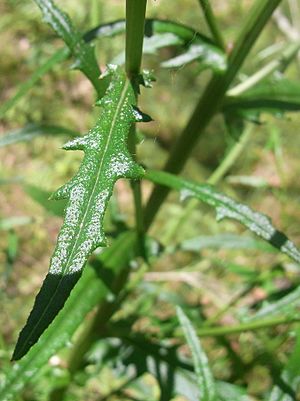Hill fireweed facts for kids
Quick facts for kids Hill fireweed |
|
|---|---|
 |
|
| Chatswood West, Australia | |
| Scientific classification |
Senecio hispidulus, also known as the hill fireweed or rough groundsel, is a type of flowering plant in the daisy family. You can find this plant in many parts of Australia and New Zealand.
Contents
What it Looks Like
Senecio hispidulus is a plant that stands upright. It can live for just one year (an annual) or for a few years (a short-lived perennial). It usually grows between 30 cm and 100 cm tall, but it can sometimes reach up to two meters. This plant is a dicotyledon, which means it has a special system for carrying water and nutrients, and it produces flowers.
The plant has many small yellow or pale-yellow flower heads. Its stems and leaves are covered with hairs. The main stem is often simple and has soft, bristly hairs. The lower part of the stem is woody and has ribs.
The leaves in the middle of the stem are usually 70–150 mm long. Their color can be dark green, yellow-green, or sometimes even reddish. The upper part of the stem can also have purple or red colors, especially when the weather is cool. The larger, lower leaves have wavy edges and are usually divided into three to five parts. The smaller leaves near the flowers are often just toothed, not deeply divided.
Each plant usually has between 14 and 48 flower heads. Each flower head contains about 25 small flowers, called florets. These mature florets are usually 6–12 mm long and 4 mm wide.
The seeds of S. hispidulus are hairy. This is why it's called Senecio, which comes from a Latin word meaning 'old man'. This name might refer to the 'bearded' or hairy seeds. The seeds are quite small, usually about 0.5 mm wide and 2 mm long.
In New Zealand, there are two slightly different types of S. hispidulus. One type grows in the northern part of the North Island, and the other grows further south. They differ in how many flower heads and florets they have.
Where it Grows
Natural Global Range
S. hispidulus is naturally found in New Zealand and Australia. In Australia, it is mostly found in New South Wales. However, you can also find it in Tasmania, Western Australia, and Queensland.
New Zealand Range
In New Zealand, S. hispidulus is common around Auckland City, the Coromandel, Ōpōtiki, and the Wellington Province in the North Island. In the South Island, it grows in Nelson, Marlborough, and North Canterbury.
Scientists have noticed that the plants in the far north of the North Island might have been brought there by people, rather than growing there naturally. There's a clear break in where the two types of S. hispidulus grow in New Zealand, which helps scientists understand how they spread.
Growing Conditions
S. hispidulus likes to grow in places like the edges of forests, open clearings, disturbed fields, coastal areas, and waste grounds. It can also be found in gardens and on farmland. It grows easily from fresh seeds and can survive in many different types of soil and habitats.
The best temperature for its seeds to sprout is around 25 °C, but most seeds sprout at 9 °C. They can even sprout at temperatures up to 35 °C. The seeds need some light to sprout, even just a little bit of daylight. This plant is known for being very weedy and can spread quickly.
Natural Enemies and Dangers
S. hispidulus can sometimes be attacked by a type of rust fungus. It is also a food source for the magpie moth.
This plant is very good at spreading and can become a weed. It contains substances called pyrrolizidine alkaloids (PAs). These PAs can be harmful to the liver and lungs if eaten. While it is potentially harmful, farm animals like cattle and horses usually do not eat it.
How to Control Hill Fireweed
S. hispidulus is usually easy to control. People use two main ways to get rid of weeds: chemical methods, like using herbicides, and physical methods, like shading.
However, hill fireweed can be resistant to some common herbicides. Because it has a shallow root system, you can often control it by pulling it out of the ground or using a hoe. But its seeds are very light and can be carried far by the wind. This means if even one plant or seed escapes, it can quickly spread again. Using a lawn mower can also help control it.
Shading is another easy and effective way to control this plant. Covering the ground with mulch can stop the seeds from sprouting. It's important to make sure no seeds blow onto the mulch and to remove any new plants that sprout as soon as possible. It's also important to stop weeds from producing seeds near potted plants, as the seeds can sprout in the clean potting mix and cause problems.
Herbicide Resistance
S. hispidulus is very adaptable, which means it can often survive control efforts and grow back. Over time, some types of fireweed have become resistant to certain herbicides. This means that even if a stronger amount of herbicide is used, it might not kill the plant.
Scientists found that some types of fireweed can resist herbicides that stop photosynthesis. These resistant plants might have different leaf structures, but they can still be less productive than the non-resistant types. Also, resistant fireweed seeds can sometimes survive longer in the soil, especially deeper down. This adaptability makes it a challenging weed to manage.

